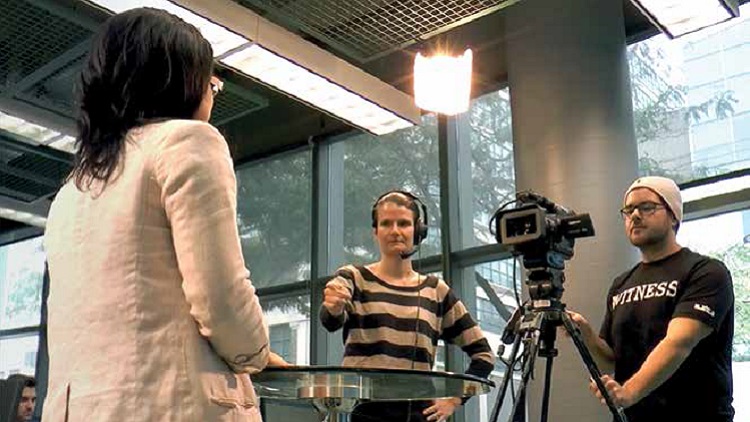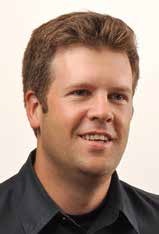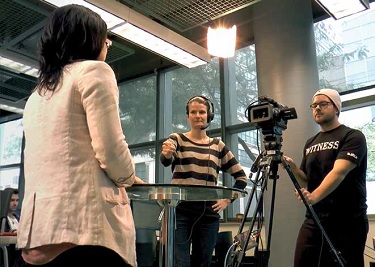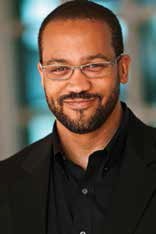Lecture Capture Moves to the Head of the Class

It’s the kind of explosion we’d hoped for in this industry. The lecture capture wave is expanding its reach in higher ed, most prominently into four-year institutions. Its initial, massive growth spurt, primarily seen in high-value presentation environments such as medical, law, and business level programs, as well as select undergrad classes, has now turned a corner, said Sean Brown, senior vice president at Sonic Foundry.

Dan Maloney, technical marketing manager, Matrox Video “We see a trend in the market from grad schools and pockets of its presence to undergraduate consideration in basic classrooms, for the majority of students,” he noted. “Lecture capture is going deeper and wider into the audiovisual infrastructure for classrooms with a higher AV profile. It’s challenging, yet very exciting.”
“In general, lecture capture hasn’t been targeted,” explained Dan Maloney, technical marketing manager, Matrox Video. “And we were surprised to learn that market penetration was far below our estimate of 25 percent. Less than 10 percent of classes have lecture capture capabilities.”
The reason? Price has been prohibitive, he said. “Lecture capture and streaming have followed a proprietary model, where CMS and device are locked together at a high price point, with an annual subscription fee often part of continued use and service.”
Secondly, the purchase cycle has been tied to administration or IT with particular focus and skill sets, Maloney said. “When staff or directives change, the technology may not suit the new needs of the school, meaning entering back into the market for a new solution that may again be proprietary.”
As CMS offerings have expanded, they’ve adopted a broad variety of sales models, he noted. “However, we see a trend toward more open CMSs. This could mean stronger partner support, enhanced API accessibility, or even collaborative open-source projects. This freedom of choice has led to a price drop on the CMS front and allowed CMS agnostic appliances to enter the market at reasonable price points.”
The use of video is exploding in higher education, and Sonic Foundry has engineered a solution for most common applications, Brown said. “Our product line covers all different levels of classroom investment, and our research and development actively follows the evolving pedagogical approaches in the university environment. Recent trends in higher education classroom infrastructure to accommodate flipped, active learning, and online learning modes demand video capture products that are optimized for these environments.”
A daily selection of the top stories for AV integrators, resellers and consultants. Sign up below.
More than 1,400 colleges and universities use Mediasite Video Platform to take courses to the next level and increase engagement and student achievement. “It’s a full video solution with a variety of recording choices and a complete range of delivery and integration options,” he explained. “Mediasite provides several recording options to create content. Room-based Mediasite Recorders completely automate content capture from any classroom or auditorium, and portable Mediasite Recorders capture live events anywhere. For desktop recording, video uploads, and personal content management, My Mediasite is a friendly software tool for any user.”
Mediasite Join video conference capture solution automatically records, streams, and manages video calls, so students can easily find and watch a missed online class, Brown said. “We continue to add features to capture video from these various learning environments. Our goal is to turn the act of teaching into academic video in as many different kinds of classrooms as possible.”
Successful Sales

Matrox Monarch Video encoding appliances allow Ryerson University journalism students to shoot and stream video on the fly while simultaneously preserving a recording on an SD card. Lecture capture is driven by three key factors: affordability, ease of use, and ease of integration, Maloney explained. “As mentioned, price has limited where lecture capture has been able to be used. It has been available in specialized programs and at schools with big endowments. Competitive prices mean that state schools and teaching universities can also implement lecture capture in classrooms and give their students the ability to learn at their own pace.”
A device can have a great price point, he noted, but if it’s difficult to use, it can be burdensome to the instructor, the IT personnel, and importantly, the tuition-paying students. “Instructors need to be able to walk into class, plug in their computer, and have it work,” he said. “CMS administrators need to know they can schedule the devices to record during lecture periods, so they can manage hundreds of classes. Students need to be able to access the materials as soon as possible, in a timely manner, so they’re not frustrated before they even start learning.”
And the devices need to be able to talk to any CMS out there. “By having the ability to speak to the CMS, lecture capture becomes fluid and almost invisible,” Maloney concluded. “The ideal device won’t be in the limelight; it will be discreet, working behind the scenes to deliver a captivating experience.”
What Students Say
Back in the day, institutions provided all academic funding. Now, with student fees, their input is needed, and they like lecture capture. “Theirs is a strong vote for it as the support used to go for distance learning,” Brown said. “Campus-wide lecture capture is mainstream and gaining momentum, fueled by student demand and decreasing tech costs. Some students may have had a class with it, but it may have been rationed, or they have just heard about it.”
Recent Sonic Foundry customers include Kansas State University, which has significantly expanded to a wider variety of students after the success of lecture capture for graduate level programs, and Texas Tech, where CIO Sam Segran has an affinity for new technology and favors a centralized approach. “Today’s student populations are diverse and mobile, and it’s important for us to find creative ways to reach everyone simultaneously in multiple locations,” Segran said. “Mediasite gives our university an edge by allowing some of our faculty and students to learn and interact at a distance without having to give up the traditional classroom feel.”
In Boulder, The University of Colorado has refreshed its system. “They’ve gone through the life cycle and are replacing and upgrading” Brown said. “Boulder is an example of people refreshing the technology in addition to adding classrooms; this is an expansion investment. Lecture capture is becoming a fixture in North America; it’s here to stay. Academic video systems that make classrooms into studios are simply a feature, a service that all students want.”
Recent Installations

More than 1,400 colleges and universities use Mediasite Video Platform to take courses to the next level and increase engagement and student achievement. Matrox started in the education sector through its Monarch HD and HDX products, which were being used to record and stream special events like convocation or sports. “IT administrators liked our products and started to see a place for them in medical observation rooms, where student nurses and doctors would be seeing patients,” Maloney said. “This allowed them to review their performance almost instantly.”
Surprisingly, classrooms were the final frontier in the educational market for Matrox, he added. “By adding isolated, yet synchronized, encoding and streaming to our feature set through the new Monarch LCS, we’re able to not only record an instructor, but we can provide the supporting lecture material, such as Keynote or PowerPoint, simultaneously. This is huge for students because they’re not getting a partial experience with recorded classes, they’re receiving an enhanced version where the information they need is at their fingertips at all times.”
The Right Fit
With a feature set that allows easy recording of lecture video, presentation material from computers, and sources from other learning devices, the Matrox Monarch LCS is a game-changer in the world of educational AV, Maloney noted. “Economically priced, at a fraction of the cost of comparable competitor products, college and university IT professionals have a CMS-agnostic streaming and recording solution that is easy to integrate. The Monarch LCS value proposition enables lecture capture in 100 percent of classrooms without affecting how instructors teach or IT administration time.”
Integrators need to know for the upcoming academic year that the experimentation is over and was successful, Brown concluded. “If you build a presentation or classroom, the expectation of how to record and deliver seamlessly, securely, and automatically is an expectation of almost any potential installation. It is a welcome addition to almost any presentation room design.
“In the old days, a smart systems designer might have waited for the client to ask about something. Now, if you’re designing a presentation space, no matter how small, take one beat and ask the client if they need strategic web-distributable video content. They will say, ‘Tell me more.’”
Karen Mitchell is a freelance writer based in Boulder, CO.
The Power of Empowering

Sean Brown, senior vice president at Sonic Foundry This fall, college and university students will be empowered to control their time better by bringing the moment of classroom lectures under their own control for replay in the times that work for them. And through the popularity of the flipped classroom model, lectures are recorded online to be watched later.
As lecture capture becomes more affordable and easier to use, every classroom becomes a class with lecture capture capabilities, Maloney said. “Until recently, this has only been possible in specialized faculties with lots of resources to devote. Widespread lecture capture is powerful because it empowers all students, raising the overall quality of education.”
The rise of multi-stream players means students can review both presentation and lecture content at their own pace while keeping all material tied together as if they were in the class. “Content management systems are complementing video, audio, and presentation material with rich metadata, which opens up a whole world of smart-study,” he added. “When a student needs to see a particular section of interest, there is no need to scan or rewatch the entire video; they can search for a term and jump to the exact point of interest.”
As recently as four years ago, a student may only have heard about a class with the luxury of the added value of watching a lecture again in addition to reading his or her notes, Brown remarked. “Now, for the 2017 academic year as students go back to school, there will be a greater likelihood they will be able to enjoy the benefits of having the proceedings of a class at their dorm room to review immediately or in the future.”
Being able to watch classes over and over is viral video for a student. “I’m passionate about this,” Brown said. “When we were the first to introduce this technology in 2002, we ran into pedagogical resistance. The fear was that the act of providing access to recorded classes would be depressant to in-person attendance and academic performance. Now we know that’s not the case.”
The number-one consumer, the student most likely to watch the lecture again, is a good student. “The students who rate lecture capture most highly are the best students,” Brown noted. “My own daughter (a recent honors graduate of the University of Minnesota) used it to make her grades even better. So it’s an ‘in addition to’ and not an ‘instead of’ technology.”
